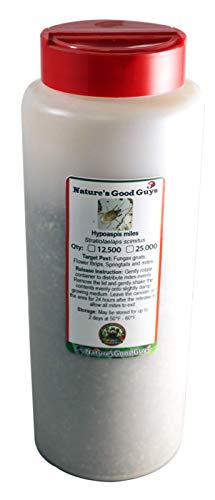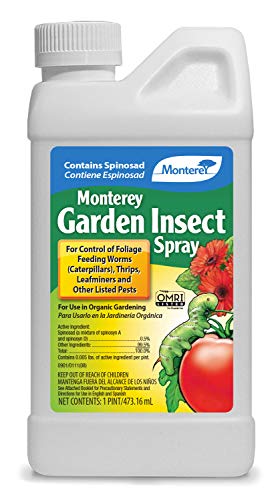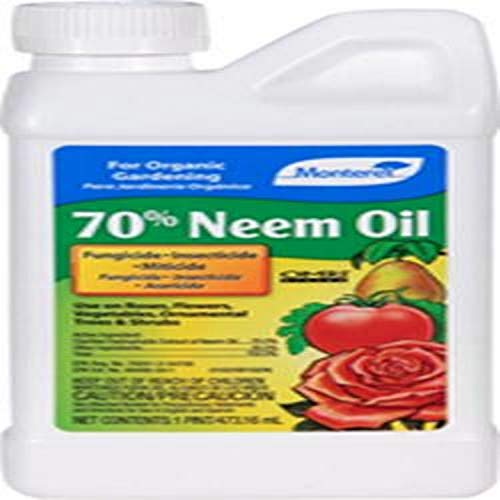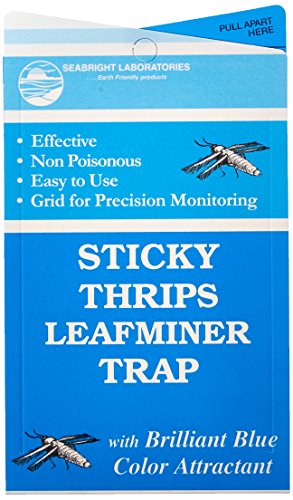How to get rid of thrips: 11 way to kill thrips on plants (Updated for 2023)


How to kill thrips on plants?
#1 Neudorff BugFree (Chemical – Editors’ Choice)
BugFree is easy to use spray that contains pyrethrins and rapeseed oil at 0.045% and 8.25% respectively as its active ingredients. Pyrethrins are extracted from the flowers of the chrysanthemums that decompose rapidly on its exposure to air and sunlight that’s why it poses no threat to the environment or humans at all and is permitted to use in organic gardening. It works well against eggs, larva and mature insects altogether. This Thrips control spray performs well if sprayed in the evening.
#2 Dragonfli Thrip Killer sachets – (Amblyseius cucumeris) (Natural – Editors’ Choice)
Amblyseius cucumeris is tan-colored predatory mites that feed Thrips on plants when applied early during the growing season. They need almost 12 days to reach the adult stage that lasts for 30 days. Adult females may further lay up to 35 eggs during this period whereas it can eat 1 Thrips in a day.
As cucumeris need 3-4 weeks for its development in the garden, its release must be timely so that it can provide long control for another 3-4 weeks. Each sachet contains 1000 predatory mites and holds an easy release method.
#3 E-Coco Products UK ORGANIC THRIPS KILLER, PESTICIDE
Its active ingredient is Chitinase derived from the worm castings concentrate. It works on the chitin of the Thrips that stops further shedding their skin and die immediately on coming contact with Chitinase. It’s strong against the Thrips while no harm to the garden plants. It’s purely organic control that is made from the red worms and provides you overnight strategy to get rid of Thrips in your edible greens and ornamental plants.
Simply point the spray aperture to the direction of infestation on your plants keeping a distance of 10 cm to give a concentrated burst. Liquid concentrate will leach down to the hiding places of Thrips and destroy them. Avoid applying if rain is expected as it reduces its efficacy to kill Thrips. Always apply in the evening and check with the dead Thrips the next morning by gently shaking the foliage. Putting a white sheet under foliage will yield the dead, that is gone.
#4 Doctor Zymes Eliminator Spray
Eliminator spray is composed of all naturally occurring materials combined with biologically stimulating ingredients using the fermentation process. Its main ingredient i.e. citric acid that works as contact poison kills Thrips that directly come under spray coverage along with other soft-bodied insects in your garden. Citric acid is considered to break down organic matter quickly that’s why Thrips eggs are broken down to organic matter before hatching takes place. It is considered a revolutionary green formula and best spray for Thrips in house and Thrips on plants as well. Moreover, due to organic listing, it can be sprayed till the day of the harvest on your garden plants. Eliminator doesn’t block stomatal openings on leaves that lead to more photosynthesis and enhance the yield of your edible greens.
Add 4 ounces of Eliminator Spray in 1 gallon of warm water using a power sprayer and completely wash your plants from upside down. No need to add any other insecticide or adjuvant while making mixtures for spray.
#5 City Hydroponics Spray and Grow Thrips Killer
This is a foliar spray that contains additional nutrients along with the killing properties of insecticide derived from different plant extracts and is considered best to kill Thrips on hibiscus and other edible plants. It is safe to use during all growth stages of the plants that ensure healthy and pest free plants in your garden. Foliar nutrients give a boost to the garden greens and edibles while essential salts of fatty acid kill Thrips biologically.
Add 25 ml of this solution in 1 liter of water and apply on the entire foliage of the plants using a mist sprayer.
#6 RHS- Bug & Mildew Control
It’s a pesticide-free ready to use spray that contains the blend of different surfactants and adjuvants that adhere thrips with the surface of the leaf, unable to move and die of starvation. It also works great against aphids, whiteflies and spider mites in the edible gardens. It also kills thrips in soil that tends to cling to the stem or shoots of the plants to reach on plant foliage. Due to its adherence qualities, it becomes a popular choice for organic gardeners to use on fruits, vegetables, and flowers. It also contains nutrients necessary to bloom and flourish flowers. No harvest interval is needed after its application on the edible greens.
#7 Bonide Captain Jack’s Dead Bug Brew
This product contains Spinosad derived from the bacteria that naturally occur in the soil. It performs well on the variety of pests including but not limited to whiteflies, aphids, codling moth, caterpillars and especially Thrips. It can be used on the variety of fruits, vegetables, and ornamentals but have certain limitations to use on microgreens and short tenure vegetables due to some residual effects that may prolong for many days after its use.
Complete coverage is needed both in the upper and lower plant foliage. Simply connect the garden hose with the concentrate bottle and follow the instruction on the label. Spraying is advised on the first sighting of the Thrips in any garden.
What are Thrips?
Bodies of most of the adults are often slender and elongate measuring less than 1/20th of inch bearing long threads on the edges of both pairs of long and narrow wings. Larvae are slender or elliptical without the formation of wings. Their color ranges from semi-transparent to white, yellow to brown and black in different species. More than 6000 species have been reported so far in different parts of the world.
What do Thrips look like?
Thrips are tiny, slender, sucking insects having fringed wings and feed on the outer layer of small leaves, tender shoots and flowers causing stippling on the upper surface of the leaves besides silvering of the lower surface of the leaves. Their color ranges from semi-transparent to white, yellow to brown and black in different species.
Where do thrips come from?
Adults feed on the pollens in the flower and the lower surface of the leaves where females lay down their elongated and kidney-shaped eggs on the leaves, curvatures and on the buds of the plant. Most of the eggs drop on the soil or within crevices where hatching takes place. Under favorable conditions, there are almost 8 generations in a year. Thrips overwinter on organic litter or debris to start reproducing upon getting favorable conditions. Some thrips come from the newly arrived nursery stuff while others through winds and rain splash in your garden.
Are Thrips harmful?
Thrips are associated with transmitting different plant viruses by feeding on your edible garden and microgreens. Topsoviruses being common among 20 virus transmitted diseases on vegetables especially Tomatoes. Besides sucking sap from the leaves and tender shoots they cause discoloration and defoliation of the leaves and de-shape the fruits and vegetables infested. This fear is more prominent when the plants are in a younger stage. Upon heavy infestations, there is a fear that they might bite you but it just causes a minor skin irritation that doesn’t last long.
How to get rid of thrips naturally?
#8 Garden Safe ASDFFG Neem Oil Extract Concentrate
This is a botanically derived formula that contains Azadirachtin in 70% Neem oil extract that works fine against Thrips, spider mites, and Aphids along with strong control over the fungi borne diseases. It’s organic and safe on all edible greens to the day of harvest. Moreover, it holds longevity in control and can be repeated without any harmful effects on the edibles.
Put 1 ounce of concentrate in 1 gallon of water and thoroughly wet plant foliage using a mist sprayer in the evening. Apply water to the plants immediately after spraying to avoid any sort of physiological stress on the leaves.
#9 Sticky Thrip Leafminer Traps
Sticky traps are the best natural way to control infestations of Thrips on your garden plants. Hang these traps at the level of plant foliage by keeping a distance of 7 feet between the traps. Traps can also be placed at the start and end of every row in your garden. Avoid them from getting dirt or replace if the infestations caught is too high to stick more insects. This is fairly cheaper and one of the best natural ways to control Thrips on all edible plants in your garden.
Coldwater treatment
Thrips infest your garden plants when the temperature is fairly high around 77°F or above and relative humidity is comparatively low. This is the time to give a burst of chilled water from the undersides of the leaves to wash Thrips away. Large scale commercial farmers often adopt this practice during the hot summer days when the infestations are high during the early stages of crop growth. This natural phenomenon works significantly well and proven across the commercial farming systems while practicing at a small scale can be more fruitful for the home gardeners. And, another option is to wait for a good rain to wash them away from your edible plants.
#10 Green Cross Isopropyl Alcohol (70%)
Isopropyl Alcohol or Rubbing Alcohol does a good job against all soft-bodied insects if you are afraid of applying insecticides to your edible greens and want to stay organic. Rubbing Alcohol contains 70% Ethanol that works on the Chitin of the insects on the exoskeleton. The melting of the chitin results in the killing of the insects as they lose the ability to molt hence die of starvation. It is necessary that the Water-Alcohol solution reach the hiding places of the insects on plants. For this reason, you need to wash your plants thoroughly using a pressure hand-Sprayer.
Add 1 part of Rubbing Alcohol to 4 parts of water and spray your plants in the evening avoiding the sensitive indoor plants. You may repeat spray after consecutive days if the infestations prolong. Furthermore, alcohol spray also destroys eggs of the Thrips lay down in the crevices of your edible plants.
#11 Harris Diatomaceous Earth (DE) food grade
Diatomaceous earth (DE) is derived from the tiny, fossilized aquatic organisms that contain several tiny pores while the insects consider these pores as their hiding place on the plants. Once they are inside DE they can’t move out as their skin tangles inside pores that don’t let Thrips come out of this stuff. The result is the restriction in their feeding that kills them at the spot where they were stuck.
Simply pour this fine mesh on the floral parts of the plants and wait for them to attack your plants. This is another best organic solution to prevent Thrips attack on your plants.
Besides working on the number of organic, natural and biological control, few cultural practices are necessary to keep your edible plants free from the infestations of the Thrips in your garden space. These practices will help you minimize all-time Thrips infestations whether you stay organic or natural;
How to prevent Thrips infestation on your plants?
– Prune and destroy leaves that are more infested with Thrips if you are growing a limited or small amount of plants in your garden.
– Control weeds and plant debris in the corners of the garden or at neglected areas of your garden because weeds serve as the alternate host of Thrips.
– Grow only those plants that are well-adapted to the climatic conditions of your garden.
– Work on the plant vigor and health by feeding them with balanced essential nutrients and fertilizers while the over-fertilizing with nitrogen may bring more infestation. Whereas, thrips damages are more often on the stressed plants.
– Try to manage fair intervals while irrigating your plants. Long irrigation gap brings dryness, more favorable for Thrips infestation.
– Apply reflective mulch or ribbons to deter Thrips flying on your plants.







